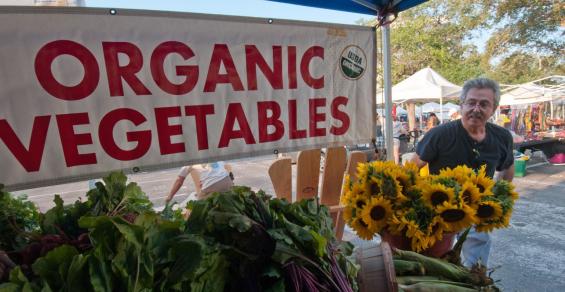USDA provides $300M for current or transitioning organic farmers through multi-agency partnership.
The number of non-certified organic farms actively transitioning to organic production dropped by nearly 71% since 2008, according to the USDA National Agricultural Statistics Service. Through the comprehensive support provided by a new Organic Transition Initiative, USDA hopes to reverse this trend, opening opportunities for new and beginning farmers and expanding direct consumer access to organic foods through increased production.
USDA’s $300 million investment is a multi-agency collaboration between USDA’s Agricultural Marketing Service, the Natural Resources Conservation Service, and the Risk Management Agency. The initiative will deliver wrap-around technical assistance, including farmer-to-farmer mentoring; provide direct support through conservation financial assistance and additional crop insurance assistance, and support market development projects in targeted markets.
“Farmers face challenging technical, cultural and market shifts while transitioning to organic production, and even during the first years after successful organic certification,” says Vilsack. “Through this multi-phased, multi-agency initiative, we are expanding USDA’s support of organic farmers to help them with every step of their transition as they work to become certified and secure markets for their products.”
Before crops can be certified organic, farmers must carefully manage their land without using prohibited inputs like synthetic pesticides for 36 months. During this transition period and during the first years after certification, farmers often face many technical and market challenges.
The three-pronged approach provides $100 million for three different areas of focus. This includes:
Transition to Organic Partnership Program: This will be administered by AMS to build partnership networks in six regions around the United States. USDA will sign cooperative agreements with a local organization in each of the six regions to play a leadership role in building paid mentorship programs to connect existing organic farmers with farmers transitioning to organic, and a host of other financial and technical assistance actions to help farmers with the transition process.
The lead organization in each region will work closely with USDA to partner with other organizations and individuals in the region to bring needed expertise and perspectives to build a regional team to implement the program.
Direct Farmer Assistance: This will be administered jointly by NRCS and RMA. Of the dedicated $100 million, $75 million of this will go to an NRCS effort to develop a new organic management conservation practice standard and offer financial and technical assistance to producers who implement the practice, with a focus on using existing nutrient management and pest management conservation practice standards in a more targeted way to relate to organic production. This NRCS funding will also be used to build organic expertise within USDA and to hire organic experts in each NRCS regional technology support center to train NRCS state and field staff to better service organic farmers.
The remaining $25 million will be used by RMA to create a new Transitional and Organic Grower Assistance Program to provide crop insurance premium subsidies for current and transitioning organic farmers, including coverage of a portion of their insurance premium.
Organic Pinpointed Market Development Support: Stakeholders have shared that some organic markets have market development risks due to inadequate organic processing capacity and infrastructure, a lack of certainty about market access, and insufficient supply of certain organic ingredients. This AMS initiative will focus on key organic markets where the need for domestic supply is high, or where additional processing and distribution capacity is needed for more robust organic supply chains.
Examples of markets seeking support include organic grain and feed; legumes and other edible rotational crops; and livestock and dairy. USDA will invest up to $100 million to help improve organic supply chains in pinpointed markets. USDA says it will seek stakeholder input on these pinpointed initiatives beginning in September, resulting in an announcement of specific policy initiatives later this year.
“Today’s announcement is the largest single investment in organic by USDA and is a big step in the right direction,” says Tom Chapman, CEO and executive director of the Organic Trade Association. “For too long, organic agriculture has been underrepresented in government programs and support, and farmers wanting to transition to organic face steep hurdles in accessing tailored organic-appropriate programs and resources at USDA.
OTA says several components of the initiative are anticipated to have the most impact on organic. This includes strengthening NRCS staff expertise in organic and agronomy certification. OTA says this will help expand access to organic experts for organic and transitioning farmers nationwide and is critical for growing organic production in historically underserved areas.
In addition, OTA says investing in regionally specific technical assistance for transitioning organic farms, will contribute to building communities and organic economic hot spots. Finally, providing direct support and incentives to help farmers participate in crop insurance is an important step towards making risk management programs work better for organic and transitioning farmers, OTA says.
The Organic Transition Initiative is consistent with many recommendations made to USDA by the National Organic Coalition to increase support for organic agriculture to help build a more ecologically sound, resilient, and climate-friendly food and farm system.
“We applaud the secretary for this public commitment to organic agriculture, and for recognizing that organic farming is critical to building a more resilient food system,” says Abby Youngblood, executive director at NOC. “The National Organic Coalition is thrilled to see USDA embracing ideas that have been promoted by our members, including farmer-to-farmer mentorship programs, new technical assistance resources, and changes in crop insurance programs, to help expand domestic organic production in a sensible manner.”
Find information about the new Organic Transition Initiative and all the USDA help for organic farmers at www.farmers.gov/your-business/organic.




